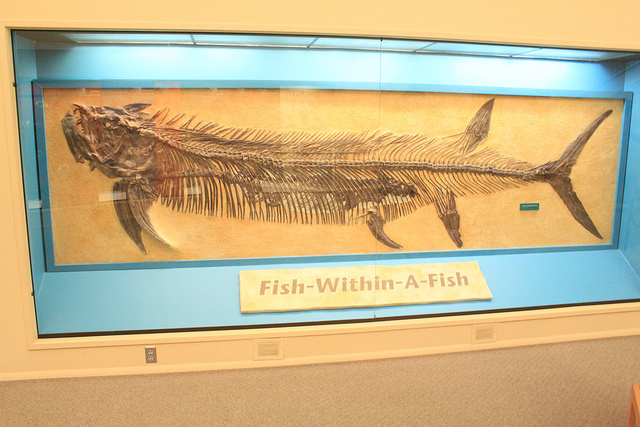
def. Xiphactinus:
1. A large (15-20 ft long), predatory fish that lived during the Late Cretaceous.
2. A prehistoric sea monster. Seriously. What an enormous and scary looking fish.
3. A really, really cool fossil. Maybe one day I can display one in the library of my evil geologist lair.
One of the most famous fossils of Xiphactinus is the “fish within a fish” fossil located at the Sternberg Museum of Natural History in Hays, Kansas. Ron Schott visited the museum several months ago and took many pictures as well as an incredible Gigapan of the “fish within a fish” fossil and some of the associated displays. Ron describes:
The centerpiece of the Sternberg Museum of Natural History in Hays, Kansas is the world renowned “Fish Within a Fish”. This remarkably complete sample from Gove County, Kansas is of a fourteen foot long Xiphactinus that had ingested an eight foot long Gillicus shortly before its demise in the Western Interior Seaway some 80 million years ago.
Here are some pictures that Ron took of Xiphactinus:









***Thanks to Ron Schott for suggesting this week’s word and providing all the wonderful scary pictures.***

I’m just an interested layperson here. It looks like those teeth are optimized for preventing live pray from backing out of the alimentary canal, not for cutting or chewing. I’m wondering what the digestive system was like. Surely the stomach can’t be as long as the prey, can it? Maybe a rupture of the internal organs as the cause of death of the outermost fish? Thanks.
LikeLike
Love the pics, but even more the “evil geologist lair!” But, then I thought, what kind of machinations would an evil geologist have anyway? (Which, then, made Madeline Kahn’s voice spring forward in my head saying “Excuse me darling, what is exactly that you do do?” — I know, I’m a geek…) So, what makes for an “evil” geologist? We’re not exactly in a world-domination type of discipline, or did I miss a meeting somewhere? We do know more than others about rocks (and beer!), but where do we go from there? I think its a great idea, but I’m afraid our minions will get bored with us when we explain that our timeframe for takeover is mega-multigenerational.
LikeLike